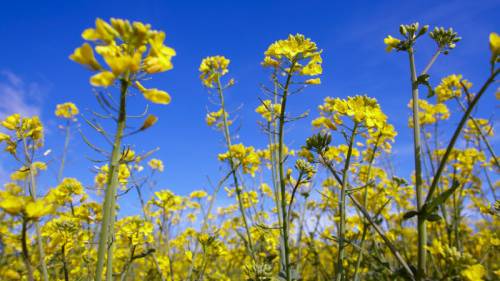‘The Great Reset’ in Global Agribusiness: 9 Black Swan Events to Watch in 2024
At this time a year ago, we gave a prediction for 2023’s “black swans” – unpredictable or unforeseen events with extreme consequences. Most of these events have come to pass and, as Trogele noted in a follow-up discussion at this past summer’s AgriBusiness Global Trade Summit on 8-9 August in Aventura, Fla., many have continued to menace the global crop inputs industry.
What black swan events are coming into focus as we head into 2024 and beyond? And what can we do now to prepare?

Bob Trogele (left) and Jim Sulecki present their nine Black Swans to watch for 2024 and beyond.
Let’s put an overarching name to these events and call it “the Great Reset.” Arguably decades have passed since this much tumult has shaken global agriculture. The 1970s and 1980s may be the closest corollary to today’s times. Then as now, inflation beset economies around the world and geopolitical uncertainty roiled the globe. The agroindustry that nearly all of us have come to know and in which we’ve spent our careers were shaped and reshaped in no small part by events of that time. Similarly the events of these years of the early and mid-2020s may come to reset global agriculture for years and decades to come.
There’s a saying that to be forewarned is to be forearmed. In that spirit, here are our nine Black Swans for 2024 and beyond – ordered by priority and the urgency with which they should be monitored.
Black Swan 1: Agroindustry Stagflation
Most demand for crop inputs globally in 2023 was expected to shrink 10%-30% depending on the region and segment. At the same time, expenses – some fixed such as wages, and some variable such as energy – have risen. This is a rare “double whammy” that is putting pressure on margins and also stock valuations across all ag input supplier segments. Expect companies in reaction to further curtail operational expenses in 2024 while also making structural changes, meaning downsizing staff and reducing capital investments.
Key question: How long will this last? Much will be answered by a follow-up question: which segment? For example, in nonselective herbicides the major factors would be the country where exposure most exists (i.e., Brazil) and the current channel inventory situation for any individual company’s portfolio there.
Black Swan 2: China Unraveling
China, due to a centralization of policy and power, is consolidating its domestic agroindustry in all aspects – manufacturing, domestic access, regulation, etc. Short term there is still a great deal of “toxicity” – meaning high-priced inventory looking for a home domestically and/or in export markets. Pricing has begun to recover, but not substantially enough to matter, and global channel inventories are being written down or reaccredited. Meanwhile the Chinese economy still struggles with GDP growth and stagnating or even declining demand, including in the purchase of ag commodities.
Key question: Will China be a reliable customer and supplier, or just a disruptive competitor? Also, as Chinese manufacturers retrench, can India, which has ramped up its own manufacturing assets, compete with China to supply global demand?
Black Swan 3: Energy
Oil prices remain elevated due to an embargo of Russia, a tightening OPEC supply, and all-time-low U.S. strategic reserves. Mideast tensions between Iran/Hamas and Israel will only put more pressure on global supply. The U.S. now produces more energy than it did pre-COVID, but refining capacity remains tight, Russian capacities impact diesel supply, and overall energy demand is increasing.
Key question: Will it take a global recession to bring supply and demand into equilibrium? In the meantime the agroindustry will likely see increases in the cost of oil-based raw materials, manufacturing, transportation, planting, input applications, and harvesting. Will the industry be capable of passing these increased costs onto consumers? If not – a likelihood – then margins will shrink and operating expenses will need to be cut.
Black Swan 4: Political De-globalization Has Led to Trade Wars and Now Physical War
It’s clear now that the Russia-Ukraine war will not be settled short term and that a clear result is not in sight. With a “war” erupting in the Gaza Strip, the situation on the doorstep of Europe becomes even more critical, and even as the continent is challenged by increased immigration, tightening energy supply, and an aging population.
Key question: How will political deglobalization affect the agroindustry midterm? EU regulations regarding maximum residue levels (MRLs) are causing havoc among producers and suppliers globally. Recent nationalistic trends are emerging – for example, increasing border controls and boycotts of Ukrainian grain and Russian oil. Further, the Europeans seem to want to favor fighting climate change over other priorities and impose that direction on the agroindustry globally. Right or wrong, the cost to do business for producers and suppliers in agroindustry is rising faster than are the prices to consumers. The European model continues to do serious damage to the agribusiness community across the value change. Meanwhile, how will the wars in Israel-Gaza and Sudan affect shipping thru the Suez Canal?
Black Swan 5: Interest Rate Inflation
The federal banks of Western nations continue to target two-percent inflation. The high cost to borrow money will have a large impact on the cash flow of businesses, and in particular agribusinesses that do not have strong balance sheets or cash flow. Cash is a key success factor.
Key question: When will the rise in interest rates reverse, how fast, and what effect will that reversal have on international trade? Today we see the dollar index decline even as the U.S. Federal Reserve Bank continues to increase rates, and the U.S. Treasury must raise $1.6 trillion by issuing new bonds. And yet, historically we are at average interest rates. Therefore, the agroindustry must transition through a number of challenges.
Black Swan 6: Labor Migration
Urbanization has caused the ultimate labor shortage for agriculture in many areas of the world, especially the Western Hemisphere. Mechanization and automation have solved many issues as producer consolidation continues around the world and economies of scale become necessary for farmers to compete globally. Even so, certain types of labor remain scarce in rural areas.
Key question: Will the global migration from south to north resolve the issue? Or will the industry need to consolidate further or automate more aggressively through technology, e.g., through robotics? The likely answer is: all of the above.
Black Swan 7: Climate Volatility
Humanity’s struggle to control the environment dates back to the invention of fire. Billions are being invested to control and stop what we humans believe is global warming. Germany alone in the last forty years has spent more than a trillion euros to achieve approximately 25% energy sourcing from alternative fuels. Fossil-fuel-limited Germans, who are fantastic inventors and engineers, have struggled to come up with the silver bullet. Climate accords have been struck, then ignored by the world’s worst polluters. Third-world countries want richer nations to pay for mitigation of global warming and we know where that ends up: in offshoring of labor.
Key question one: How will producers deal with increased governmental regulations on the farm? How about manufacturers of fertilizers and chemicals? Again, cost is going up faster than margins. Can we afford the switch to “cleaner” energy sources? And will it work?
Key question two: Will the effect of El Niño continue to disrupt the major American river systems and further disrupt the Panama Canal? Global agriculture is dependent on a stable water transport system to move bulk commodity products to where the demand is.
Black Swan 8: Continuing Regulatory Pressure
Our highly regulated agroindustry is under even more scrutiny than it ever has been before. Bottom line: more regulations result in more costs along the value chain. Certain areas of the world such as the U.S. and the EU will become increasingly and even wholly non-competitive. Witness the shift of row-crop production to South America, and the shift in the manufacturing of chemical inputs to the East. Further, regions that have declining populations and inherited wealth are less concerned today about food security and food cost and so are less inclined than they may have been in the past to be worry over outsourcing and offshoring of food production.
Key question: Can the EU countries and the U.S. sustain their agricultural footprint? Especially if deglobalization and destabilization of nations, for example Ukraine, can cause shortages. Further, as the cost of food has risen, so has the demand for trendy healthy foods, especially among the younger population. Can we afford this cost of “emotional” EU regulatory overreach and cost-changing consumer demands?
Black Swan 9: Technology Continues to Push into Agribusiness and the Agroindustry
With major companies having invested and continuing to invest in technology – for example, the $300 million Nutrien has spent on digital solutions and its data team in the past five years – the trend is clear: artificial intelligence will further drive how business is executed at the farm gate. For example, equipment dealers are signing on to visorPro.ai from Canadian start-up AGvisorPRO so their technicians can ask a powerful AI any support query question using a chat interface. Other companies continue to raise money, such as start-up Rantizo, whose recent $6 million expansion of funding is targeted to help ag retailers scale automation of drone aerial applications.
Key question: Will the agroindustry as a whole ride the initial wave of practical AI? Or largely sit it out with a wait-and-see attitude? If margins remain tight, the best bet is likely the former as much as the latter.





